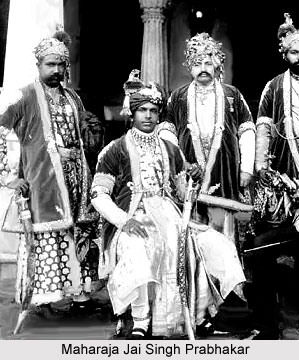 Jai Singh Prabhakar was a prominent ruler or Maharaja of the princely state of Alwar, which is currently known as Alwar District in the state of Rajasthan in the northwest of India. It was a unit of British rule in India that was not directly administered by the British East India Company. Jai Singh Prabhakar ruled over the territory from the year 1892 to 1937. He was born on 14th June 1882 as the only son of Maharaja Sir Mangal Singh Prabhankar Bahadur, who was the preceding ruler. Although Maharaja Jai Singh was rather charming, brilliant and erudite during his early years, but eventually he became brutal, sadistic and extravagant.
Jai Singh Prabhakar was a prominent ruler or Maharaja of the princely state of Alwar, which is currently known as Alwar District in the state of Rajasthan in the northwest of India. It was a unit of British rule in India that was not directly administered by the British East India Company. Jai Singh Prabhakar ruled over the territory from the year 1892 to 1937. He was born on 14th June 1882 as the only son of Maharaja Sir Mangal Singh Prabhankar Bahadur, who was the preceding ruler. Although Maharaja Jai Singh was rather charming, brilliant and erudite during his early years, but eventually he became brutal, sadistic and extravagant.
Rule of Jai Singh Prabhakar
Jai Singh Prabhakar, the Maharaja of Alwar, idolized himself and utilised the wealth of the princely state for his own personal needs. The British authorities were falsely reported that the condition of the princely state of Alwar was rather excellent, when in fact the reality was much different. Under his rule the state suffered from financial chaos and the requirements and reforms of his subjects were overlooked. Eventually Jai Singh Prabhakar was accounted for his negligence and misdemeanor and a Board of Inquiry set up by the British officials found him guilty that was convened in the year 1933. He was exiled from the state of Alwar by the British Government and was stripped of his rank, power and titles. Further more, he was prohibited from entering the princely state of Alwar again in future and as long as he lived.
Personal Life of Jai Singh Prabhakar
Later Maharaja Sir Jai Singh Prabhakar went into exile in France. After four years, he died on 19th May 1937 at Paris, at the age of fifty four. Tej Singh Prabhakar Bahadur, a distant relative, succeeded him and ascended the throne of Alwar.
Titles of Jai Singh Prabhakar
Jai Singh Prabhakar held numerous titles and styles through out his reign over the princely state of Alwar. These are discussed below-
* Yuvaraja Shri Jai Singh Sahib, Yuvaraja Sahib of Alwar (1882- 1892)
* His Highness Raj Rishi Shri Sawai Maharaja Jai Singh Veerendra Shiromani Dev Bharat Prabhakar Bahadur, Maharaja of Alwar (1892- 1909)
* His Highness Raj Rishi Shri Sawai Maharaja Sir Jai Singh Veerendra Shiromani Dev Bharat Prabhakar Bahadur, Maharaja of Alwar, KCSI (1909- 1911)
* His Highness Raj Rishi Shri Sawai Maharaja Sir Jai Singh Veerendra Shiromani Dev Bharat Prabhakar Bahadur, Maharaja of Alwar, KCSI, KCIE (1911- 1915)
* Lieutenant-Colonel His Highness Raj Rishi Shri Sawai Maharaja Sir Jai Singh Veerendra Shiromani Dev Bharat Prabhakar Bahadur, Maharaja of Alwar, KCSI, KCIE (1915- 1919)
* Lieutenant-Colonel His Highness Raj Rishi Shri Sawai Maharaja Sir Jai Singh Veerendra Shiromani Dev Bharat Prabhakar Bahadur, Maharaja of Alwar, GCIE, KCSI (1919- 1921)
* Colonel His Highness Raj Rishi Shri Sawai Maharaja Sir Jai Singh Veerendra Shiromani Dev Bharat Prabhakar Bahadur, Maharaja of Alwar, GCIE, KCSI (1921- 1924)
* Colonel His Highness Raj Rishi Shri Sawai Maharaja Sir Jai Singh Veerendra Shiromani Dev Bharat Prabhakar Bahadur, Maharaja of Alwar, GCSI, GCIE (1924- 1937)
Honours of Jai Singh Prabhakar
Maharaja Sir Jai Singh Prabhakar was honoured several times, which are mentioned as follows-
* Delhi Durbar Gold Medal (1903)
* Delhi Durbar Gold Medal (1911)
* Knight Grand Commander of the Order of the Indian Empire- GCIE (1919) and KCIE (1911)
* Knight Grand Commander of the Order of the Star of India- GCSI (1924) and KCSI (1909)



















